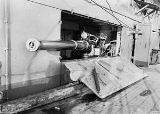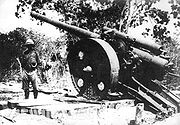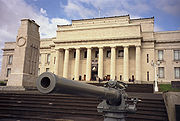
BL 4 inch naval gun Mk VII
Encyclopedia
The BL 4-inch gun Mk VII was a British high-velocity naval gun introduced in 1908 as an anti-torpedo boat
gun in large ships, and in the main armament of smaller ships. It was also used as a defensive weapon on Defensively Equipped Merchant Ships
(DEMS) during the Second World War.
The gun was succeeded in the "heavy" 4-inch class on new warships commissioned from 1914 onwards by the QF 4 inch Mk V
. This new generation of warships were more heavily armed, and the BL Mk VII's role as secondary armament on capital ship
s and primary armament on cruisers was taken over by the BL 6 inch Mk VII
and BL 6 inch Mk XII
while the 4-inch calibre became the secondary armament on cruisers and primary armament on destroyers.
In World War II
many guns were used to arm merchant ships.
 A battery of 4 guns mounted on field carriages was first deployed with the South African Heavy Artillery in the German South West Africa campaign in 1915 and returned to England in September. They were then deployed in the East African Campaign
A battery of 4 guns mounted on field carriages was first deployed with the South African Heavy Artillery in the German South West Africa campaign in 1915 and returned to England in September. They were then deployed in the East African Campaign
from February 1916 with 11th Heavy Battery (renumbered 15th Battery from April 1916) manned by the Royal Marine Artillery.

Torpedo boat
A torpedo boat is a relatively small and fast naval vessel designed to carry torpedoes into battle. The first designs rammed enemy ships with explosive spar torpedoes, and later designs launched self-propelled Whitehead torpedoes. They were created to counter battleships and other large, slow and...
gun in large ships, and in the main armament of smaller ships. It was also used as a defensive weapon on Defensively Equipped Merchant Ships
Defensively Equipped Merchant Ships
Defensively Equipped Merchant Ship was an Admiralty Trade Division program established in June, 1939, to arm 5,500 British merchant ships with an adequate defence against enemy submarines and aircraft...
(DEMS) during the Second World War.
Naval history
The guns armed the following warships :- Bellerophon class battleshipsBellerophon class battleshipThe Bellerophon class was a class of three dreadnought battleships that were built in the United Kingdom prior to World War I, and served in the Royal Navy during the war. The Bellerophons were near carbon copies of the previous , with the exception of a second tripod mast...
laid down 1906 - St. Vincent class battleshipsSt. Vincent class battleshipThe St. Vincent class battleships consisted of three ships of the Royal Navy laid down in 1908, and completed between May 1909 and April 1910. They were St. Vincent, Collingwood, and Vanguard. Vanguard was destroyed in an ammunition explosion, probably due to bagged cordite.Visually, they were very...
laid down 1907 - Boadicea class scout cruisersBoadicea class cruiserThe Boadicea class was a two ship class of scout cruisers of the Royal Navy, consisting of HMS Bellona and HMS Boadicea. They were the first class to be fitted with turbine machinery, propulsion which became standard for all future cruisers...
laid down 1907 - HMS NeptuneHMS Neptune (1909)HMS Neptune was a Royal Navy dreadnought battleship, intended to be the lead ship of three Neptune-class battleships, but the subsequent two ships had slightly thicker belt armour and were reclassified as the Colossus class.-Design:...
laid down 1909 - Colossus class battleshipsColossus class battleship (1910)The Colossus class of two battleships - Colossus and Hercules of the British Royal Navy were among the first battleships following the original of 1906. Originally intended to be part of the Neptune class, the two ships had thicker armour and other differences from , and so Neptune is...
laid down 1909 - Indefatigable class battlecruisersIndefatigable class battlecruiserThe Indefatigable class were the second class built of British battlecruisersThe Indefatigable-class ships were formally known as armoured cruisers until 1911 when they were redesignated as battlecruisers by an Admiralty order of 24 November 1911. Unofficially a number of designations were used...
laid down 1909 - Orion class battleshipsOrion class battleshipThe Orion class battleships were four super-dreadnoughts — the first ships of that type — of the Royal Navy. The lead ship, , was launched in 1910. They were the first Royal Navy dreadnoughts to have all their main guns in the centreline, although the U.S. South Carolina class had this advanced...
laid down 1909 - Lion class battlecruisersLion class battlecruiserThe Lion class were a class of battlecruisers built by the British Royal Navy before World War I. Nicknamed the "Splendid Cats", the ships were a significant improvement over their predecessors of the in terms of speed, armament and armour...
laid down 1909 - Bristol class light cruisers laid down 1909
- Blonde class scout cruisersBlonde class cruiserThe Blonde class cruisers were a two ship class of light scout cruisers of the British Royal Navy. They were developments of the earlier Boadicea class class, though were slightly bigger with ten 4 inch guns as their main armament.-History:...
laid down 1909 - Active class scout cruisersActive class cruiserThe Active class was a class of three scout cruisers of the Royal Navy, built prior to the First World War, and later seeing service in that conflict...
laid down 1910 - King George V class battleshipsKing George V class battleship (1911)The King George V class battleships were a series of four Royal Navy super-dreadnought battleships built just prior to and serving in the First World War.The King George V class immediately followed the Orion class upon which they were based....
laid down 1911
The gun was succeeded in the "heavy" 4-inch class on new warships commissioned from 1914 onwards by the QF 4 inch Mk V
QF 4 inch Mk V naval gun
The QF 4 inch Mk V gun was a Royal Navy gun of World War I which was adapted on HA mountings to the heavy anti-aircraft role both at sea and on land, and was also used as a coast defence gun.-Naval service:...
. This new generation of warships were more heavily armed, and the BL Mk VII's role as secondary armament on capital ship
Capital ship
The capital ships of a navy are its most important warships; they generally possess the heaviest firepower and armor and are traditionally much larger than other naval vessels...
s and primary armament on cruisers was taken over by the BL 6 inch Mk VII
BL 6 inch Mk VII naval gun
The BL 6 inch Gun Mark VII was a British naval gun dating from 1899, which was mounted on a heavy traveling carriage in 1915 for British Army service to become one of the main heavy field guns in the First World War, and also served as one of the main coast defence guns throughout the British...
and BL 6 inch Mk XII
BL 6 inch Mk XII naval gun
The BL 6 inch Gun Mark XII was a British 45 calibres naval gun which was mounted as primary armament on light cruisers and secondary armament on dreadnought battleships commissioned in the period 1914 - 1926, and remained in service on many warships until the end of World War II.-Design:This was a...
while the 4-inch calibre became the secondary armament on cruisers and primary armament on destroyers.
In World War II
World War II
World War II, or the Second World War , was a global conflict lasting from 1939 to 1945, involving most of the world's nations—including all of the great powers—eventually forming two opposing military alliances: the Allies and the Axis...
many guns were used to arm merchant ships.
World War I field gun service

East African Campaign (World War I)
The East African Campaign was a series of battles and guerrilla actions which started in German East Africa and ultimately affected portions of Mozambique, Northern Rhodesia, British East Africa, Uganda, and the Belgian Congo. The campaign was effectively ended in November 1917...
from February 1916 with 11th Heavy Battery (renumbered 15th Battery from April 1916) manned by the Royal Marine Artillery.
Surviving examples

- 2 Mk VII guns from HMS New Zealand outside the Auckland War Memorial MuseumAuckland War Memorial MuseumThe Auckland War Memorial Museum is one of New Zealand's most important museums and war memorials. Its collections concentrate on New Zealand history , natural history, as well as military history.The museum is also one of the most iconic Auckland buildings, constructed in the neo-classicist...

